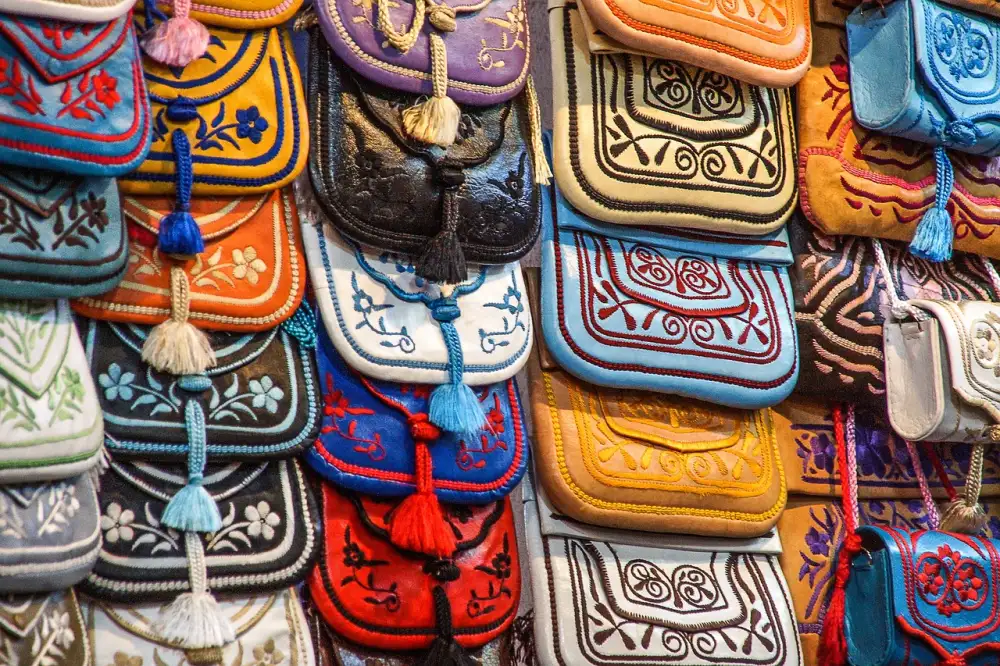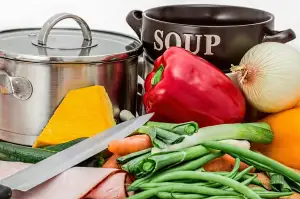Discover the Exquisite Flavors of Moroccan Cuisine: Unveiling Authentic Moroccan Food Recipes

- Traditional Moroccan Spices: Unveiling the Secrets of Flavorful Delights
- Tagine: The Iconic Moroccan Dish that Will Transport Your Taste Buds
- Couscous: A Staple of Moroccan Cuisine with Endless Variations
- Moroccan Street Food: Exploring the Vibrant Flavors of the Medina
- Moroccan Tea Ritual: Sip on the Authentic Mint Tea Experience
- Moroccan Desserts: Indulge in Sweet Delicacies from the Kingdom of Sweets
- Vegetarian Moroccan Dishes: Discover the Richness of Plant-Based Cuisine
- Moroccan Breakfast: Start Your Day with a Delicious and Nutritious Spread
- Moroccan Food Culture: Unraveling the Traditions and Customs Surrounding Meals
Moroccan cuisine is a treasure trove of flavors and aromas that will transport you to the exotic land of Morocco. With its rich history and diverse influences, Moroccan food is a delightful fusion of Berber, Arab, and Mediterranean culinary traditions. From fragrant spices to succulent tagines, every dish tells a story and reflects the vibrant culture of this North African country. Get ready to embark on a culinary journey filled with tantalizing tastes and unforgettable experiences as we delve into the world of Moroccan cuisine.
Traditional Moroccan Spices: Unveiling the Secrets of Flavorful Delights
Traditional Moroccan cuisine is renowned for its rich and aromatic flavors, which are achieved through the skillful use of a variety of spices. These spices not only add depth and complexity to dishes but also reflect the cultural diversity and historical influences that have shaped Moroccan cuisine over centuries.
One of the most essential spices in Moroccan cooking is cumin. Its warm, earthy flavor forms the backbone of many traditional dishes such as tagines and couscous. Another staple spice is paprika, which lends a vibrant red color and smoky sweetness to dishes. Ginger adds a subtle heat and zing, while turmeric imparts a golden hue and earthy taste.
Moroccan cuisine also embraces the boldness of chili peppers, with both fresh and dried varieties used to add heat to dishes. Cinnamon, cloves, and nutmeg bring warmth and sweetness to savory dishes like lamb tagine or chicken bastilla.
The unique blend of spices known as ras el hanout is a true treasure in Moroccan cuisine. This complex mixture can contain up to 30 different spices including cardamom, coriander, allspice, saffron, and rose petals. It is often used as a seasoning for meat or rice dishes, adding an irresistible aroma and depth of flavor.
By incorporating these traditional Moroccan spices into your own cooking, you can unlock a world of tantalizing flavors that will transport you straight to the bustling markets of Marrakech or the winding streets of Fez. So go ahead, embrace the secrets of Moroccan spice blends and embark on a culinary adventure like no other.
Tagine: The Iconic Moroccan Dish that Will Transport Your Taste Buds
Tagine is the iconic dish of Moroccan cuisine that will take your taste buds on a journey to the exotic land. It is a slow-cooked stew, traditionally made in a clay pot with a conical lid. The tagine is known for its aromatic flavors and tender meat, infused with a blend of spices like cumin, turmeric, ginger, and saffron. Whether it's lamb, chicken, or vegetable tagine, this dish captures the essence of Moroccan cooking. The long hours of simmering allow the flavors to meld together, creating a rich and hearty meal that is truly unforgettable.
Couscous: A Staple of Moroccan Cuisine with Endless Variations
Couscous, a staple of Moroccan cuisine, is a versatile dish that can be enjoyed in countless ways. Made from semolina wheat, it is light and fluffy, serving as the perfect base for a variety of ingredients. From vegetables and meat to dried fruits and nuts, the possibilities are endless when it comes to couscous variations. Whether it's a hearty lamb and vegetable tagine served over couscous or a refreshing salad with fresh herbs and citrus, each dish showcases the vibrant flavors of Moroccan cuisine. The art of preparing couscous lies in the steaming process, which ensures its delicate texture. This beloved grain has become synonymous with Moroccan culture and is a must-try for any food enthusiast looking to explore the diverse flavors of this exotic land.
Moroccan Street Food: Exploring the Vibrant Flavors of the Medina
Moroccan street food is a vibrant and exciting culinary experience that allows you to immerse yourself in the bustling atmosphere of the Medina. As you wander through the narrow alleyways, your senses will be overwhelmed by the enticing aromas and colorful displays of food stalls. From savory snacks to sweet treats, there is something for every palate.
One popular street food dish is "b'stilla," a savory pastry filled with layers of spiced meat, almonds, and eggs. The combination of flavors and textures creates a truly unique taste sensation. Another must-try street food is "harira," a hearty soup made with lentils, chickpeas, tomatoes, and fragrant spices. It is often enjoyed during Ramadan as a way to break the fast.
For those with a sweet tooth, Moroccan street food offers an array of delectable options. "Chebakia" is a fried pastry coated in honey and sprinkled with sesame seeds. Its intricate shape makes it not only delicious but also visually appealing. Another popular sweet treat is "msemen," a flaky pancake that can be filled with anything from honey to cheese.
As you indulge in these street food delights, take note of the vibrant atmosphere around you. The hustle and bustle of locals bargaining for their favorite dishes adds to the charm of the experience. Soak up the energy of the Medina as you savor each bite and discover the true essence of Moroccan cuisine on the streets where it all began.
Moroccan Tea Ritual: Sip on the Authentic Mint Tea Experience
No visit to Morocco is complete without indulging in the traditional Moroccan tea ritual. Known as "Atay," this aromatic drink holds a special place in Moroccan culture and hospitality. The star ingredient of this refreshing brew is fresh mint leaves, which are combined with gunpowder green tea and a generous amount of sugar.
The preparation of Moroccan tea is an art form in itself. The water is boiled, and the tea leaves are steeped multiple times to extract the full flavor. The addition of fresh mint leaves adds a delightful burst of freshness and aroma to the tea.
Served in small, ornate glasses, Moroccan mint tea is not just a beverage but an experience. It is customary for the host to pour the tea from a height, creating a frothy layer on top. This technique also helps to cool down the scalding hot liquid.
The first sip of Moroccan mint tea will transport you to another world. The combination of sweet and refreshing flavors instantly invigorates your senses. The vibrant green color and fragrant aroma add to its allure.
Beyond its delicious taste, Moroccan mint tea holds symbolic significance. It represents hospitality, friendship, and warmth. It is often served as a gesture of welcome to guests or during social gatherings.
To recreate this authentic experience at home, bring water to a boil and add gunpowder green tea leaves along with fresh mint leaves. Let it steep for a few minutes before adding sugar to taste. Pour from a height into small glasses and savor every sip.
Whether enjoyed alone or shared with loved ones, sipping on Moroccan mint tea allows you to immerse yourself in the rich culture and traditions of Morocco. So sit back, relax, and let the enchanting flavors transport you to the bustling streets of Marrakech or the serene landscapes of Chefchaouen
Moroccan Desserts: Indulge in Sweet Delicacies from the Kingdom of Sweets
Moroccan desserts are a true delight for those with a sweet tooth. From rich pastries to fragrant sweets, the Kingdom of Sweets offers a wide array of indulgent treats. One popular dessert is the Moroccan almond cookie, known as "ghriba." These crumbly cookies are made with ground almonds, sugar, and fragrant spices like cinnamon and cardamom. Another beloved dessert is the "msemen," a flaky pancake that can be enjoyed plain or filled with honey, nuts, or cheese. And let's not forget about the famous Moroccan orange cake, made with fresh oranges and topped with a sweet glaze. Whether you're craving something nutty, fruity, or chocolaty, Moroccan desserts have something to satisfy every palate. So go ahead and indulge in these sweet delicacies from the Kingdom of Sweets!
Vegetarian Moroccan Dishes: Discover the Richness of Plant-Based Cuisine
Moroccan cuisine is a treasure trove for vegetarians, offering a wide array of flavorful and satisfying plant-based dishes. From hearty stews to vibrant salads, the richness of Moroccan vegetarian cuisine will leave you craving for more. One popular dish is the Moroccan vegetable tagine, where an assortment of vegetables are slow-cooked with aromatic spices, creating a harmonious blend of flavors. Another must-try is the traditional Moroccan lentil soup, a comforting bowl of goodness packed with protein and nutrients. Whether you're a vegetarian or simply looking to explore new culinary horizons, Moroccan cuisine has something delightful in store for you.
Moroccan Breakfast: Start Your Day with a Delicious and Nutritious Spread
Moroccan breakfast is a delightful way to start your day, with a spread that is both delicious and nutritious. Typical Moroccan breakfast dishes include msemen, which are flaky, square-shaped pancakes served with honey or jam. Another popular option is baghrir, also known as Moroccan crepes, topped with butter and honey. For a heartier meal, try bissara, a thick soup made from fava beans and spices. And of course, no Moroccan breakfast would be complete without a cup of strong, aromatic Moroccan coffee or refreshing mint tea.
Moroccan Food Culture: Unraveling the Traditions and Customs Surrounding Meals
Moroccan food culture is deeply rooted in traditions and customs that add a unique charm to every meal. One of the most important aspects of Moroccan dining is the concept of sharing. Meals are often enjoyed with family and friends, with large platters placed at the center of the table for everyone to dig in. This communal style of eating fosters a sense of togetherness and creates a warm and welcoming atmosphere.
Another interesting tradition is the use of bread as a utensil. In Morocco, bread is not just an accompaniment but an essential part of the meal. It is used to scoop up stews, tagines, and dips, adding texture and flavor to each bite.
Hospitality is highly valued in Moroccan culture, and guests are always treated with great respect. When invited to someone's home for a meal, it is customary to bring a small gift or dessert as a token of appreciation.
Meals in Morocco are also known for their slow pace. Eating is seen as a time for relaxation and enjoyment, with conversations flowing freely between bites. It is common for meals to last several hours, allowing people to savor each dish and engage in meaningful conversations.
Furthermore, traditional Moroccan meals often begin with a series of small appetizers called "mezze." These can include olives, preserved lemons, salads, and dips such as hummus or baba ganoush. Mezze allows diners to sample various flavors before moving on to the main course.
Lastly, it's important to note that Moroccans have specific customs when it comes to eating with their hands. The right hand is considered clean while the left hand is used for personal hygiene purposes. Therefore, it is customary to eat using only your right hand as a sign of respect.
By understanding these traditions and customs surrounding Moroccan meals, you can fully immerse yourself in the rich cultural experience that Moroccan cuisine offers. So gather your loved ones, embrace the slow pace, and savor the flavors of this enchanting culinary journey.
In conclusion, the enchanting flavors of Moroccan cuisine are waiting to be discovered and embraced in your own kitchen. With its rich blend of spices, aromatic tagines, and endless variations of couscous, Moroccan food offers a culinary experience like no other. Whether you're a meat lover or a vegetarian, there are plenty of options to satisfy your taste buds. Don't forget to explore the vibrant street food scene and indulge in the sweet delights of Moroccan desserts. And let's not forget the traditional tea ritual that adds a touch of elegance to every meal. So why not bring a taste of Morocco into your home and embark on a delicious journey that will transport you to this exotic land?
Published: 03. 12. 2023
Category: Food



